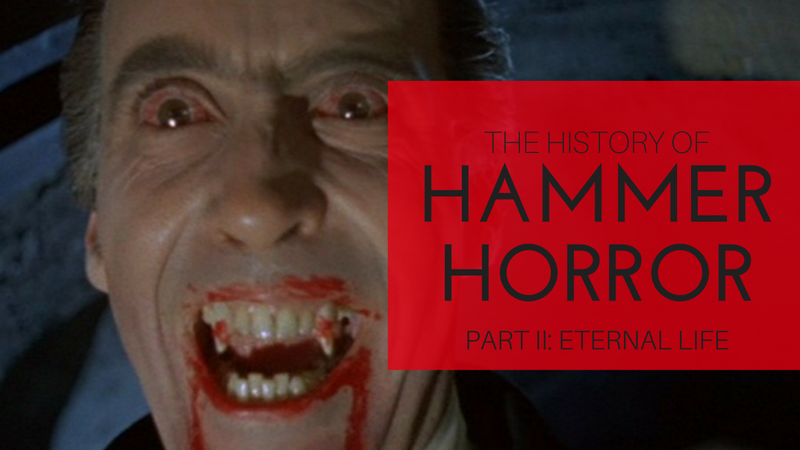
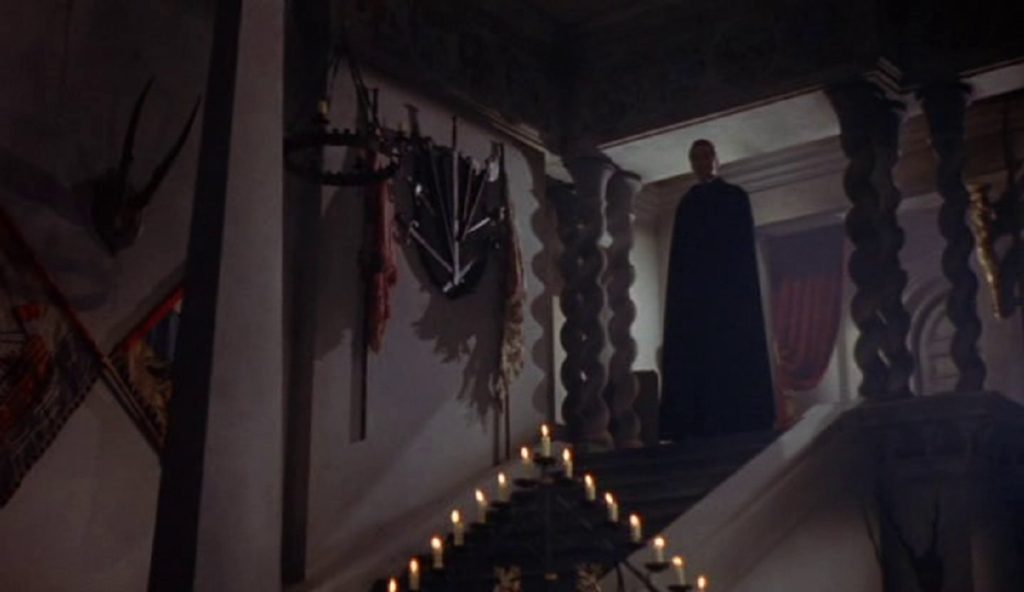
Following the huge success of The Curse of Frankenstein, Hammer went into production on an adaptation of Dracula. Hammer had reinvented horror and had done so while receiving massive profits. There was absolutely no way they were going to slow down now. So they did what they did best. They asked their small crew to create a large number of movies over a short amount of time with very little money.
And they delivered.
When Curse was released in 1958, Hammer went into overdrive, creatively and productively. They churned out more classic horror films in the next decade and a half than most studios could hope for in a lifetime. Throughout that heyday — and well after it, I might add — Hammer continued to release Dracula films. The first of which was directed by Terence Fisher and written by a fairly important figure in the history of Hammer. Someone I completely failed to mention in Part 1.
Jimmy Sangster worked a few jobs around the studio in the earlier days: production manager, production assistant, assistant director. His first writing job was The Curse of Frankenstein and he apparently had a knack for it. He was then, of course, enlisted to write the adaptation of Bram Stoker’s Dracula. Sangster’s draft ended up being fleet, streamlined and loaded with the kind of action and gore you’d never expect from a gothic horror. While Sangster later tried his hand at directing and completely whiffed it, his contributions to the sustained period of success Hammer saw cannot be understated.
A couple of other guys were integral to the ongoing, worldwide success of Hammer’s horrors and I did manage to mention them in Part 1. While Peter Cushing is my favourite Hammer era actor, Christopher Lee is the one with the largest cultural impact. For good reason too. His imposing stature may have landed him the role of the Creature in Curse but it was the intensity of his performance that pierced through the makeup and showed the producers a little glimpse of what would make Lee indispensable to the Hammer canon.
Lee always seemed to come across in interviews like he was above the genre films he starred in, or disdained them. What I find when I read the quotes and see the interviews — and what gels better with how his friends and costars saw him — is more a playfulness. He was a very dignified man, but also very funny. I see his complaining about the qualities of the films, or basically being blackmailed to be in them, or saying he just chose not to read any lines in certain pictures, as a kind of showmanship. He’s playing the heel.
Whether or not he truly tired of the Dracula role early on, he continued to knock it out of the park. It was a joy to see him in the cape and it was even more of a joy to see him act opposite Cushing. They became lifelong friends thanks to Hammer and the two men starred in more than 20 films together.
Horror of Dracula (1958)
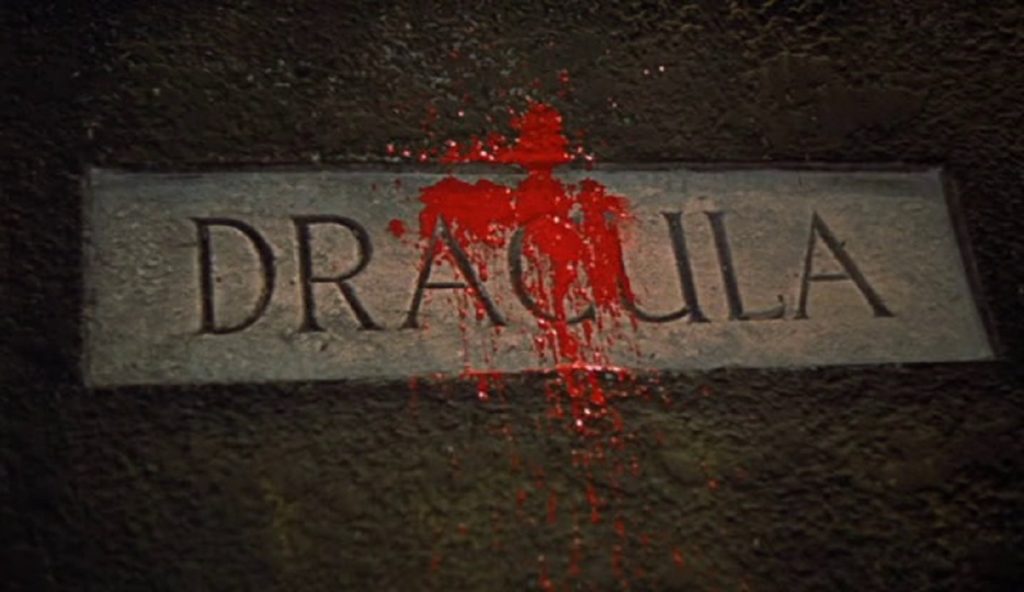
I believe that this is the best screen adaptation of Dracula. It isn’t the most accurate to Bram Stoker’s book and it may not even have the best performance of Dracula — Bela Lugosi is a high bar to clear, and Gary Oldman is no slouch — but it has my favourite performance as Dracula and it’s the most entertaining adaptation. It streamlines the story in interesting ways. One of the biggest changes is turning Jonathan Harker into a vampire hunter, which creates an urgency and tension from the start. We also get to see Dracula as a much more feral creature than the Universal adaptation showed us. His regality is very quickly revealed to be a facade and we see that he is very much an animal, or a living virus, something later adaptations would delve into with relish.
Horror has all the hallmarks of classic Hammer, mainly because it’s one of the films to create them. Gothic castles, scared villagers, upper-crust pish-poshers and lots of cherry red house paint blood. The main story is a condensed version of Stoker’s, with Cushing’s Van Helsing given a bigger focus. Cushing plays well against disbelievers, and Michael Gough is a great supporting character with a believable transition from doubter to desperate helper.
The greatest thing about Horror, besides the atmosphere and gore and legacy, is the solid action. The finale is a standout after a deliberate buildup of mostly slow, sensual and slyly sinister scenes. There’s an explosion of conflict between Van Helsing and Dracula and both Lee and Cushing throw everything they have into it. Dracula’s death is one of my favourite horror movie moments. After an all out struggle it’s Van Helsing’s ingenuity that wins out over Dracula’s animal instincts. Cushing running along the table and leap at the curtains to reveal daylight makes you want to jump to your feet and applaud. When he grabs two candlesticks and uses them as a makeshift cross it’s not only clever, it’s just the beginning of Van Helsing’s improvisational skills in the series.
What shouldn’t be overshadowed is Lee’s ability to sell Dracula’s loss. Throughout the film he’s either assured, menacing and overbearing or he’s blood-drunk and rabid. The death scene is played so real, you can absolutely see the pain in Lee’s face as he meets his end. It’s just one example of Lee’s absolute commitment to the role and it makes me look forward to his character’s demise in every subsequent film.
The Brides of Dracula (1960)
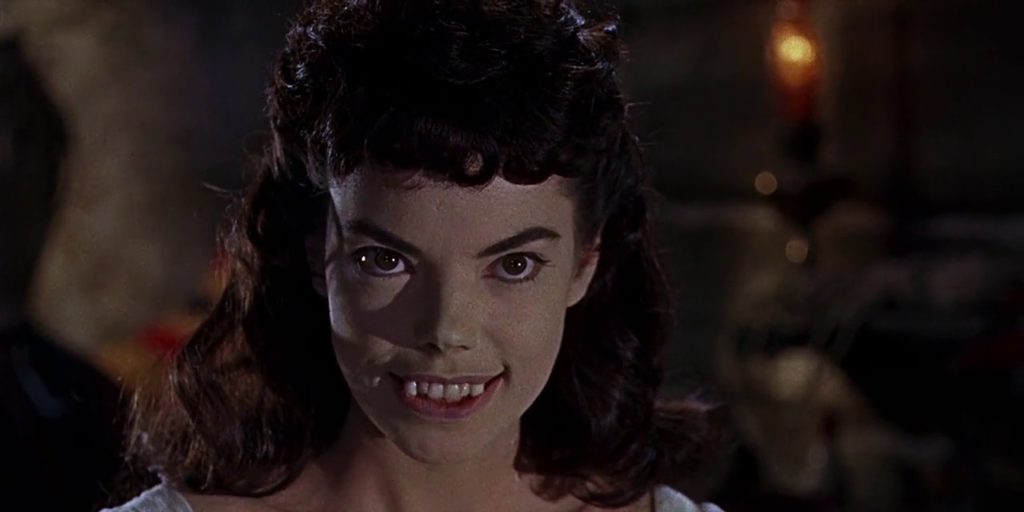
There’s literally only one part of this movie I don’t like. It seems like it would be a huge, movie-ruining part, but The Brides of Dracula is a movie I enjoy almost as much as the first one. The major issue with this film is the villain. The vampire, Baron Meinster played by David Peel, is the weak link in a really solid follow-up. He has the unfortunate task of following Lee and going up against Cushing. It doesn’t help that his vampire-teeth work is sub-par, causing him to pull goofy faces, and he’s coiffed like an undead Liberace.
Luckily, as the title would suggest, the vampire women are the star of the show most of the time. While they don’t get much to do which isn’t in service of their man — an unfortunate reality of many Hammer pictures — their performances still manage to stand out. Martita Hunt is the head of the pack as Baroness Meinster, the Baron’s crazed mother. She manages to shift through all sorts of emotions, coming off as menacing and pitiable at equal turns. Yvonne Monlauer as Marianne, the object of Meinster’s affection, doesn’t fare as well with what is written, but she acquits herself admirably. The most visually arresting vampire in the whole film is easily Gina, played by Andree Melly. Her wide-eyed euphoria isn’t really something we’ve seen before and it resembles a fanatic. Before she’s turned she plays a fairly thankless “best friend” role, but ironically she absolutely comes to life once she’s turned into a vampire.
Again the finale is an impressive action set piece. Van Helsing fights off vampires inside a burning windmill in order to rescue Marianne, cauterizing a neck bite by himself and using my favourite example of crucifix improvisation to destroy Meinster. The finale is an absolute showcase for Cushing’s ability to literally throw himself into the role. If Lee’s absence wasn’t casting such a long shadow over the proceedings this would maybe be my favourite Hammer Dracula film.
Dracula: Prince of Darkness (1966)
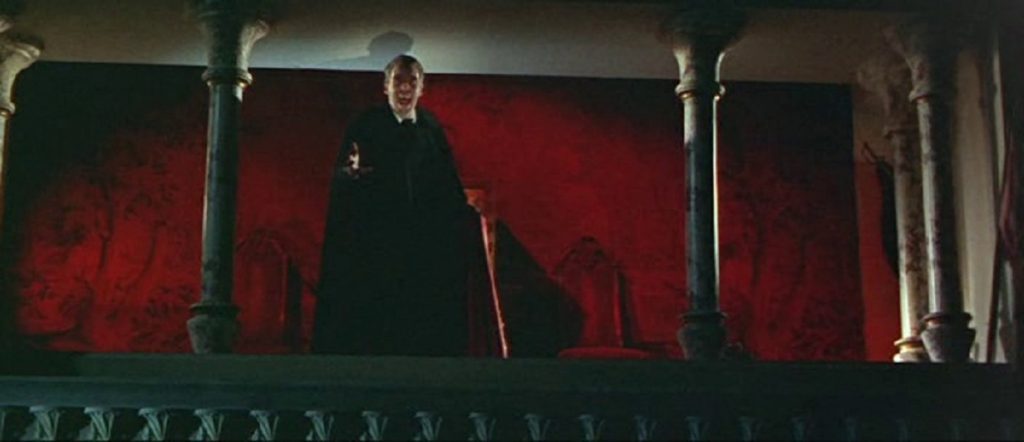
Dracula: Prince of Darkness is the first Cushing free entry in the series. His presence is sorely missed. There just isn’t as good a personality as Van Helsing for us to latch onto when it comes to opposing Dracula. However, Lee makes his return to the franchise and he’s as great as he was in Horror, as is to be expected.
There’s a bit of a disagreement over Dracula’s presence in this film. Sangster, who wrote the film, claims that Dracula was never given any lines whereas Lee stated that there were lines but they were so bad that he refused to say them. I tend to believe Sangster while still enjoying Lee’s justification. Either way, it works perfectly. With no dialogue Dracula becomes a force of nature. Almost a ghoul, haunting the castle and the travellers unfortunate enough to be drawn in. He’s an animal and it even ends with him hissing at his assailant as he’s cornered with a rifle.
My main problem with Darkness is the lack of a really good hero to cheer for. The first two entries set the bar high with Cushing. This one at least has Francis Matthews (previously from Revenge of Frankenstein) and Barbara Shelley in the quartet that stays the night at Dracula’s castle. Unfortunately their characters are pretty milquetoast and hard to cheer for besides the usual “I don’t really want Dracula to kill people” feelings we’re supposed to have. Even the religious figure, Andrew Keir’s Father Sandor, is a big drag. He basically takes over the Van Helsing role but with more bluster and piousness and it just becomes obnoxious.
Luckily Dracula has a much better arsenal in the form of his man-servant, Klove. Phillip Latham plays Klove as very outwardly creepy so we all know what’s up the minute we spot him. It’s just a matter of time before he’s hanging someone upside down and slitting their throat. Unfortunately this will be the last good, reliable Renfield stand-in Dracula will have in this series.
Of course, the reason to watch the film is Lee himself. Regardless of whose story is the correct one, Lee’s wordless performance is pure charisma. And it’s the reason the series endured.
Dracula Has Risen from the Grave (1968)
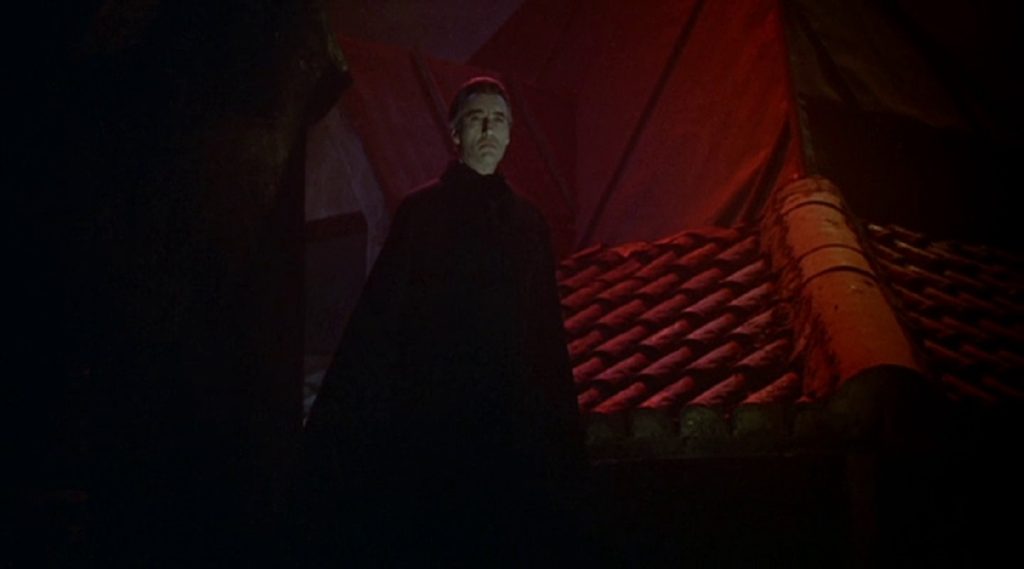
First thing’s first when it comes to this film. There’s absolutely no sense going any further without mentioning its poster. I would argue one of the greatest posters of all time:

Now that that’s out of the way . . .
Things get pretty interesting in Dracula Has Risen from the Grave. While Hammer was basically built on how much sexual subtext you can shove into a horror picture, this movie deals with it in a fairly straightforward manner. It also ties faith and religion up into it, which creates the perfect microcosm of what Dracula represents. At its basest level Dracula is animal instinct, which means sex as much as death. The mere notion of propriety, for example a cross, sends him hissing across the room. Think of how much film is devoted to Dracula trying to free cleavage from the crucifix atop it. Dracula is a predator who slinks in through an open door or window, or he’s the tall, dark stranger invited in willingly. Either way, Risen turns textual what everything else was alluding to, with varying results.
Lee’s Dracula returns, through whatever convolution this film decided to think up. (A priest’s blood runs into a crack in the ice where Dracula’s body is frozen from the previous film, in case you were wondering.)
As usual, we have a few human heroes in this film. There’s Rupert Davies as the blowhard Monsignor who blocked Dracula’s castle with a big metal crucifix. There’s Veronica Carlson as his niece Maria. Most interestingly is Barry Andrews as the bland hero, Paul. What sets Paul apart from bland heroes, past and present, is his atheism. I was a little surprised when it came up during a scene with Maria’s uncle and rolled my eyes at the thought of this being an “atheist finds religion” story. But it didn’t really turn out that way. Andrews also surprised me. At first he seemed like a bigger, dumber, Hugh Grant, but for some reason his doofy charm grew on me and I actually enjoyed him. The movie continued to surprise by having Paul stick with his convictions by swearing to do what he has to do to protect Maria without actually compromising his beliefs. It was kind of bold for a film from 1968
Even at the climax of the film, when the Monsignor on his deathbed told Paul he had to say some words of God to vanquish Dracula, it was the priest-turned-Renfield who showed up and finished the job. (Paul does cross himself, but it’s fairly cursory as to be more of a button on the film itself than a big transition in Paul’s character.) I kind of love the idea of holding steadfast in your beliefs despite the prevailing wisdom — and, honestly, common sense when there’s a dang Dracula running about — and Andrews was good enough to make me enjoy it here.
It should also be noted that Veronica Carlson plays Maria in this film and, despite being given a thankless role in Frankenstein Must Be Destroyed just a year later, acquits herself quite nicely as Maria.
Taste the Blood of Dracula (1970)
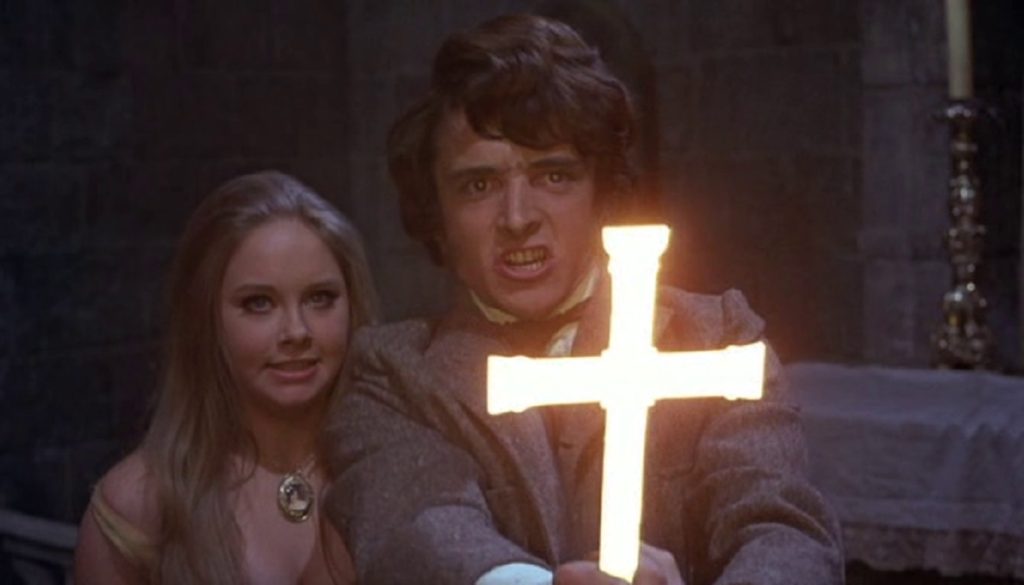
I’ll give this move some credit for shaking things up a bit. No one stumbles upon Castle Dracula or is beset by the vampire’s henchmen. This story is about a bunch of awful, bourgies, debauched rich guys who need a little extra thrill and happen upon just the guy who can deliver. Taste the Blood of Dracula is a weird film in that it’s filled with some good scenes and a solid idea but overall I don’t much care for it.
I wasn’t that surprised to find out Lee’s Dracula was kind of a late addition to the film. Originally, Lord Courtley (played by Ralph Bates, a late Hammer icon) was supposed to rise as a vampire and take vengeance on the men who killed him. Hammer, however, convinced Lee to return and they shot the film with Dracula as the vengeful spirit. Which doesn’t quite jive. It makes sense that he’d return from the dead and it makes sense that he’d maybe feed from or enslave the people who helped him, but I don’t buy him caring enough about a servant to bother enacting revenge.
Like I said though, there are some things that work. The prologue, about an antiquities dealer who happens to witness Dracula’s demise in Risen, is a really solid opening. The premise itself is a new one to the franchise, if not exactly fresh overall. Unfortunately, there’s not enough meat on the bones, and even including the studio mandated nudity at the time, there’s barely enough spectacle for the runtime.
As usual, Christopher Lee is great. He plays such a good silent stalker you can see why he was an influence on John Carpenter’s Halloween. Unfortunately, the finale of the film is a big letdown. I’m a huge fan of the improvised weapons of the series, but Dracula backing into a window pane which is sort of like a crucifix is a little farfetched. He then hears religious voices in his head and falls to his death. It’s too easy and too lame. Taste, overall, is one of my least favourite in the series and a lot of that has to do with missed opportunities.
Scars of Dracula (1970)
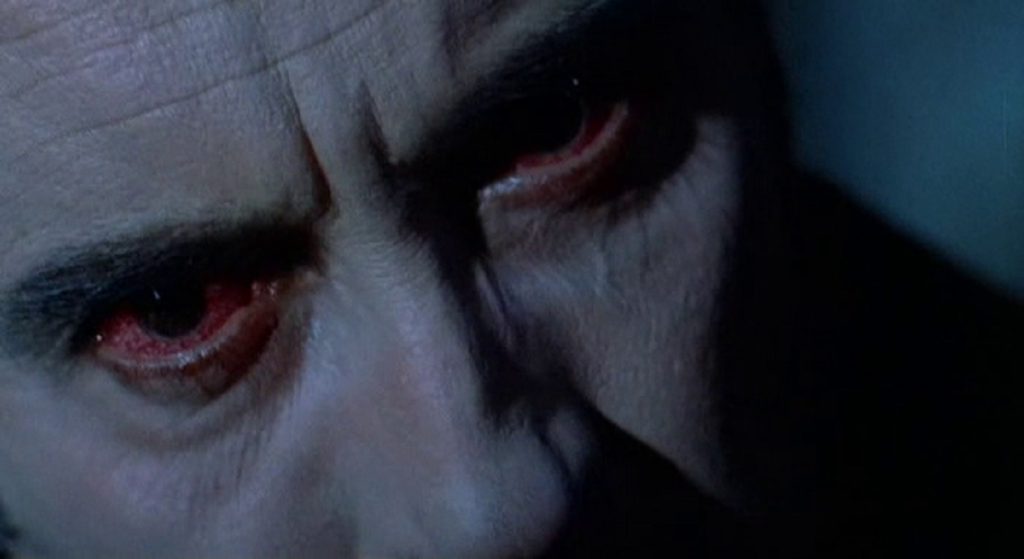
Scars of Dracula has a ridiculously good opening. At first it seems a little slow, showing a really poor bat puppet and the resurrection of Dracula himself, but then it delves into the meat of it. We then get our first truly horrific scene in this series in a while. Every woman and child is in the church while the men go to kill Dracula. When he’s not there they return to find everyone in the church has been slaughtered. It’s a truly upsetting scene, sold completely by Michael Gwynn (the Creature in Revenge of Frankenstein) as the local priest.
When the story proper begins we’re again left with a pretty sorry bunch of protagonists. Paul, played by Christopher Matthews, is a shiftless rogue that isn’t really charismatic enough or developed enough to actually root for. Dennis Waterman as his brother Simon and Jenny Hanley as his love interest, Sarah, don’t fare that much better. The best moments in this film are contained within Dracula’s castle.
Doctor Who‘s Patrick Troughton plays Klove, presumably no relation to the Klove from Darkness, a conflicted man-servant. He’s easily Dracula’s worst Renfield-a-like to date. Even though the brainwashed Priest in Risen killed him at the end, he was at least fairly loyal up until then. Klove is wishy-washy throughout. Sometimes he’s cutting up body parts, other times he’s letting people escape. Pick a lane, Klove.
Altogether there’s a little too much travelling back and forth between the tavern in town and Dracula’s castle. It kills a lot of the tension. The movie’s secret weapon is actually Gwynn. He was great as the Frankenstein’s Creature and is just as good here, but he’s used too little too late. It’s also unfortunate that his character meets his end at the fangs of a poorly utilized bat puppet.
Overall, Scars is oddly forgettable, save for a scene or two of solid horror. Lee, as always, gives it everything he’s got. His death especially — as lame a cop-out as Dracula being struck by lightning is — shows how much effort he puts into every second he’s on-screen.
Dracula A.D. 1972 (1972)
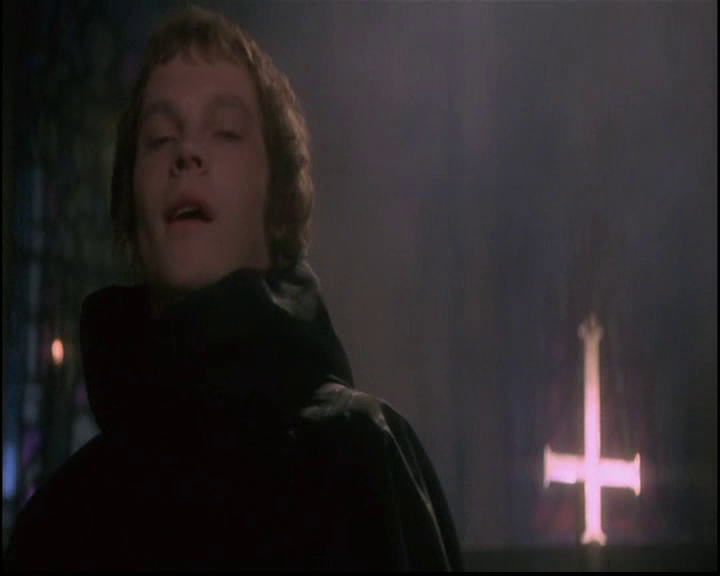
Hammer horror films were entering a new age by the time Dracula A.D. 1972 was filmed. The Dracula franchise decided to jump into that head first by bringing the story of Dracula forward to the present day. I don’t know if I’d call it successful. It certainly wasn’t playing to Hammer’s strengths, but it was definitely a change of pace. The six movies prior to this one had become a little samey, A.D. definitely changed that.
I tend to enjoy A.D. more than the general consensus. I think a huge part of that is the triumphant return of Peter Cushing as Van Helsing. His return is shown in the prologue, a fantastic action set piece with a runaway carriage and an improvised stake in the form of a broken carriage wheel. Honestly, Cushing’s return to the series almost made me jump for joy. As great as Lee is, it’s such a pleasure to have someone just as strong on the other side to balance things out.
After the prologue things jump ahead . . . considerably. We’re brought to then-present day Britain. Unfortunately we’re subjected to an interminable opening where a bunch of counter-culture buffoons “stick it to the man” by partying, having sex and doing drugs. It’s really lame these days and I assume it was as lame then as it is when we see “youth speak” in current films.
Luckily that kind of stuff “mellows out” when we get to the meat of the story. Johnny Alucard (GET IT?!) convinces his friends that the real thrill isn’t LSD or jazz cigarettes, it’s raising Dracula from the dead. They reluctantly agree and, predictably, all hell breaks loose There’s a difference this time compared to the last few times though: Peter Goddamn Cushing.
Cushing returns to the series — looking older and more gaunt due to personal reasons while still maintaining the ridiculous dedication to character — as a relative of the original Van Helsing. The movie creates a more personal connection between Dracula and Van Helsing, with Christopher Neame’s Alucard specifically targeting Van Helsing’s granddaughter, Stephanie Beacham’s Jessica.
A.D. definitely has the advantage of novelty. It’s cool seeing Dracula and Van Helsing running around 1970’s London. Some of that may even be projected nostalgia from me, but I still enjoy it as an exciting change of pace. Not only is Lee fantastic, he also has his best henchman since the original Klove in Christopher Neame’s Johnny Alucard. First of all, Alucard is a Robert Webb-looking bastard:
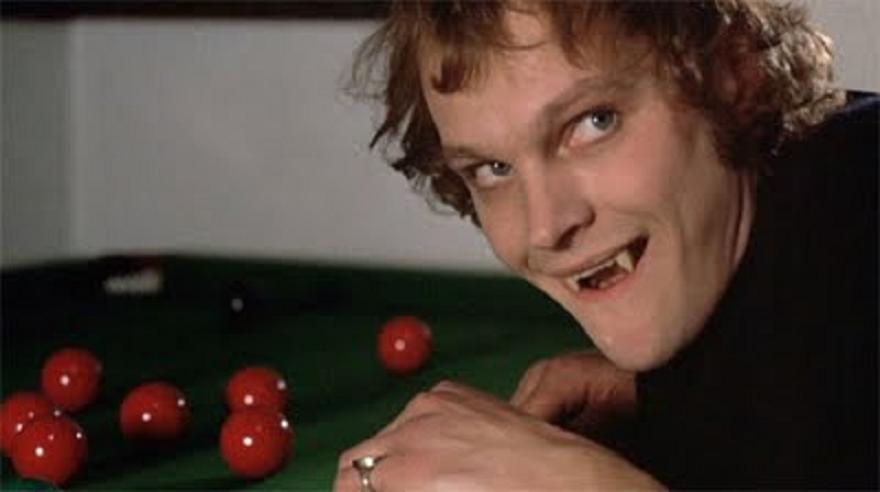
Second of all, they have the single greatest minion-to-Dracula exchange — maybe even the greatest exchange in Hammer Dracula history — after Alucard goes through a gruelling, blood-letting ceremony to resurrect Dracula.
Alucard: “Master, I did it! I summoned you!”
Dracula: “It’ was my will.”
That blasé dismissiveness is so incredibly Dracula that you could basically just watch a clip of that scene and come away with a solid understanding of Lee’s performance.
But don’t! A.D. seems like it’s going to be a bit of a slasher film at first, but after two victims — unfortunately women, another example of Hammer’s damsel-in-distress problem — they play it straight when it comes to a Dracula film. There’s another exciting actioner between Lee and Cushing, not quite as lively as Horror, and a fittingly gruesome end to Dracula in the church graveyard.
Could this be the start of a solid, present-day run of Dracula films for Hammer?
The Satanic Rites of Dracula (1973)

No, it couldn’t.
Unfortunately, Hammer decided to immediately follow up A.D. with The Satanic Rites of Dracula. Rites is one of my least favourite of the Hammer Dracula series and a big part of that is the fact that it’s a waste of potential. There’s so much that could have been explored in a 70’s Dracula series, even if you included the silly Bond-knockoff B-movie stuff, that the final product feels like a failure.
The intelligence service comes to Van Helsing for help with the occult. This doesn’t seem out of place in any number of high concept fantasy crime procedurals that have been on TV in the last ten or so years. It’s fairly new when it comes to Hammer films though. And it’s actually pretty exciting too, when you have Cushing dropping the exposition. Prior to that you’ve got what feels like 30 minutes of poorly written spy talk trying to catch a trend.
Rites has a few solid moments. When Michael Coles’s Inspector Murray and Joanna Lumley’s Jessica Van Helsing (a recast from the previous film) are attacked by shackled vampire slaves it’s effective, and it’s the first film in the series to give Lee and Cushing a chance to talk. It’s only a few minutes, but it’s entrancing, even with Lee’s face hidden in the shadows. There’s a reason the two play off each other so well and it’s entirely exemplified in that scene.
The finale is a fiery set piece which works well but is kind of too little too late. The spy stuff just doesn’t gel, which is unfortunate. I dig the idea of Van Helsing as an intelligence officer and Dracula as a CEO but this movie barely does anything with either idea. As a swan song to Lee’s Dracula and Cushing’s Van Helsing sharing the screen it’s acceptable, if overall unimpressive.
The Legend of the 7 Golden Vampires (1974)

What you get is what you see on the tin when it comes to this movie.
Hammer joined with Shaw Brothers (a company which released a number of Wuxia films that I’m ill-equipped to talk about) to recapture some of that B-movie glory. By 1974 Hammer’s star was fading, but Kung Fu flicks were still ruling the second-run cinema.
When I started writing this whole piece I actually ended up watch The Legend of the 7 Golden Vampires for the first time. I was surprised by how much I liked it. There were at least 3 or 4 genre-defining moments in the movie itself. Whether it was Peter Cushing’s Van Helsing teaching a bunch of students just like Indiana Jones or the truly horrific dead rising in the flashback sequence, which must have been an influence on Return of the Living Dead and Army of Darkness at least.
Christopher Lee doesn’t reprise his role as Dracula in this film. It’s understandable considering how tacked-on the Van Helsing presence seems. Unfortunately, what we do get is a Lee stand-in with terrible stage makeup. The smartest thing the film does is make a prologue with the character inhabiting a visually distinct and interesting character, Kah, played by Shen Chan.
The film generally plays out like a Wuxia flick with a fairly forced reason for Van Helsing to be there. One of the upsides of the film is that there are two fairly strong female characters, at least when it comes to Hammer pictures. There’s Julie Ege as Vanessa Buren, a headstrong woman who finances their travels and has a roundabout attachment to David Chiang’s Hsi Ching. There’s also Shih Szu as Mai Kwei, one of the siblings trying to protect their village from vampire rule.
The weirdest part of the film is how unnecessary Van Helsing’s son is. Leyland, played by Robin Stewart, only exists to be a love interest for Mai. It’s completely unnecessary since Ching both has a romantic storyline with Vanessa and a father-son relationship with Van Helsing. Overall, it’s an adventure story, from point-a to point-b with exactly what you’d expect in-between.
The biggest surprise this late in the game is the ingenuity. Clearly changing the time and setting breathed new life into the production. In the flashback of what Van Helsing describes in the classroom, we get one of the best “zombies-come-to-life” scenes put to film. The action and final stand-off is very well-filmed. There’s only one issue I have with the finale.
At the beginning of the film, Dracula (as played by John Forbes-Robertson and dubbed by David de Keyser) is met by Kah and takes his form. It’s new and interesting and works with the rest of the movie. Any time we see a glimpse of Shen Chan as Dracula he knocks it out of the park. So when Cushing has his final confrontation with Dracula and makes him turn back into his “original form” it’s a little disappointing. We’ve seen Cushing destroy Lee before. The last thing we want to see is Cushing destroy a Lee stand-in wearing bad stage makeup.
The greatest thing to come from Hammer’s Frankenstein and Dracula series isn’t the generations of filmmakers they’ve influenced. It’s the friendship it created between Lee and Cushing. Two men who deserve top honours in the Hall of Horror.
As Christopher Lee himself put it, speaking of Peter Cushing:
I don’t want to sound gloomy, but at some point of your lives, every one of you will notice that you have in your life one person, one friend whom you love and care for very much. That person is so close to you that you are able to share some things only with him . . . And then when that person is gone, there will be nothing like that in your life ever again.
Other Movies to Watch (Obviously)
There are a large number of vampire movies, from great to terrible to everything in between. I think an underrated and sadly under-seen standout in the genre is Kathryn Bigelow’s Near Dark from 1987. It isn’t gothic horror, it’s country-fried western horror, but it’s as much an American vampire movie as The Horror of Dracula is a British one. The 1992 Francis Ford Coppola film Bram Stoker’s Dracula is definitely worth a look. Arguably Coppola’s last really good film, the cast is extremely solid and game — save for a terrible Keanu Reeves accent — and the gothic horror influences are strong. Anthony Hopkins’s Van Helsing and Gary Oldman’s Dracula make formidable opponents for the all-time throne. Cushing and Lee still hold it, but it’s not exactly a blowout.
I’d also like to recommend, now that I’ve gotten through Frankenstein and Dracula, the Showtime series Penny Dreadful. Eva Green, Timothy Dalton and Josh Hartnett star in this House of Frankenstein-esque mashup of familiar monsters and tropes reimagined in fun ways. The series is mostly The Eva Green Show — like most things she stars in — but Timothy Dalton and Rory Kinnear put in fantastic supporting performances and Josh Hartnett is the best he’s ever been.
Coming Up in Part 3 . . .
While these franchises continued to stretch out Hammer was releasing other genre-defining horror movies which are well worth a closer look.
In Case You Missed It . . .

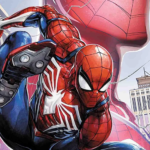

![[REVIEW] ‘THE LUDOCRATS’ REMINDS US NOT TO BE BORING](https://geekd-out.com/wp-content/uploads/2020/03/The-Ludocrats-Featured-150x150.jpg)